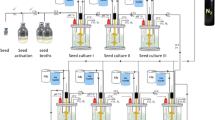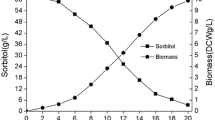Abstract
Stoichiometric analysis is applied to continuous glycerol fermentation by Clostridium butyricum to calculate theoretical maximum yields and to predict preferred pathways under different conditions. The upper limits of product concentration and productivity as a function of dilution rate in continuous culture is also predicted from product inhibition kinetic. The theoretical maximum propanediol yield (0.72 mol/mol glycerol) which is calculated for a culture without hydrogen and butyric acid formation agrees well with the experimental maximum value (around 0.71 mol/mol). Comparisons of experimental results (product concentration and productivity) with theoretical calculations and those of the glycerol fermentation by Klebsiella pneumoniae reveal that the production of 1,3-propanediol by C. butyricum is far below the optimum performance available with the present strain. One of the reasons is the relatively high formation of butyric acid under the culture conditions so far applied. The distribution of reducing equivalents to propanediol and hydrogen is also suboptimal. The utilization of the reducing power from pyruvate oxidation for propanediol production is about 60–70% of the theoretical maximum under the present experimental conditions.
Similar content being viewed by others
References
Tran-Dinh, K.; Hill, F.F.: Verfahren zur Herstellung von 1,3-Propandiol. German patent no. DE 3734764 A1, 1989
Gottschalk, G.; Averhoff, B.: Process for the microbial preparation of 1,3-propanediol from glycerol. European patent no. EP 0373230 A1, 1990
Günzel, B.;Yonsel, S.;Deckwer, W.-D.: Fermentative production of 1,3-propanediol from glycerol by Clostridium butyricum up to a scale of 2 m3. Appl. Microbiol. Biotechnol. 36 (1991) 289–294
Biebl, H.;Marten, S.;Hippe, H.;Deckwer, W.-D.: Glycerol conversion to 1,3-propanediol by newly isolated clostridia. Appl. Microbiol. Biotechnol. 36 (1992) 592–597
Streekstra, H.;Teixeira de Mattos, M.J.;Neijssel, O.M.;Tempest, D.W.: Overflow metabolism during anaerobic growth of Klebsiella aerogenes NCTC 418 on glycerol and dihydroxyacetone in chemostat culture. Arch Microbiol. 147 (1987) 268–275
Forsberg, C.W.: Production of 1,3-propanediol from glycerol by Clostridium butyricum and other Clostridium species. Appl. Environ. Microbiol. 53 (1987) 639–643
Homann, T.;Tag, C.;Biebl, H.;Deckwer, W.-D.;Schink, B.: Fermentation of glycerol to 1,3-propanediol by Klebsiella and Citrobacter strains. Appl. Microbiol. Biotechnol. 33 (1990) 121–126
Zeng, A.-P.;Biebl, H.;Schlieker, H.;Deckwer, W.-D.: Pathway analysis of glycerol fermentation by Klebsiella pneumoniae: Regulation of reducing equivalent balance and product formation. Enzyme Microb. Technol. 15 (1993) 770–779
Menzel, K.; Zeng, A.-P.; Deckwer, W.-D.: High concentration and productivity of 1,3-propanediol from glycerol fermentation by Klebsiella pneumoniae in continuous culture. Enzyme Microb. Technol. 1995 (submitted)
Tag, C.G.: Mikrobielle Herstellung von 1,3-propanediol. Ph. D Thesis, University of Oldenburg, FRG, 1990
Günzel, B.: Mikrobielle Herstellung von 1,3-Propandiol durch Clostridium butyricum und adsorptive Abtrennung von Diolen. Ph.D. thesis, TU Braunschweig, FRG, 1991
Solomon, B.O.;Zeng, A.-P.;Biebl, H.;Posten, C.;Deckwer, W.-D.: Comparison of the energetic efficiencies of hydrogen and oxychemicals formation in Klebsiella pneumoniae and some Clostridia during anaerobic growth on glycerol. J. Biotechnol. 39 (1995) 107–117
Ruch, F.E.;Lengeler, J.;Lin, E.C.C: Regulation of glycerol catabolism in Klebsiella aerogenes. J. Bacteriol. 119 (1974) 50–56
Neijssel, O.M.;Hueting, S.;Crabbendam, K.J.;Tempest, D.W.: Dual pathways of glycerol assimilation in Klebsiella aerogenes NCIB 418. Their regulation and possible function significance. Arch. Microbiol. 104 (1975), 83–87
Forage, R.G.;Foster, M.A.: Glycerol fermentation in Klebsiella pneumoniae. Functions of the coenzyme B12-dependent glycerol and diol dehydratases. J. Bacteriol. 149 (1982) 413–419
Lin, E.C.C.: Glycerol dissimilation and its regultion in bacteria. Ann. Rev. Microbiol. 30 (1976) 535–578
Vasconcelos, I.;Girbal, L.;Soucaille, P.: Regulation of carbon and electron flow in Clostridium acetobutylicum grown in chemostat culture at neutral pH on mixtures of glucose and glycerol. J. Bacteriol. 176 (1994) 1443–1450
Herbert, D.;Phipps, P.J.;Strange, R.E.: Chemical analysis of microbial cells. In: Norris JM, Ribbons DW (eds) Methods in Microbiology, vol 5b, Academic Press, New York, 209–344, 1971
Zeng, A.-P.;Ross, A.;Biebl, H.;Tag, C.;Günzel, B.;Deckwer, W.-D.: Multiple product inhibition and growth modeling of Clostridium butyricum and Klebsiella pnenumoniae in glycerol fermentation. Biotechnol. Bioeng. 44 (1994) 902–911
Reimann, A.; Biebl, H.: Influence of iron, phosphate and methyl viologen on glycerol fermentation of Clostridium butyricum. Poster presented at the 7th European Conference on Biotechnology. March 19–23, Nice, France, 1995
Zeng, A.-P.: Effect of CO2 absorption on the measurement of CO2 evolution rate in aerobic and anaerobic continuous cultures. Appl. Microbiol. Biotechnol. 42 (1995) 688–691
Barbirato, F.; Grivet, J.P.; Bories, A.: Glycerol fermentation to 1,3-propanediol by Enterobacterial species and related inhibition by an intermediate metabolite: 3-hydroxypropionaldehyde. Poster (# MEP 55) presented at the 7th European Congress on Biotechnology, Nice, France, 1995
Cameron, D.C.; Skraly, F.A.; Wilard, B.L.; Zhu, M.-Y.; Held, A.M.; Shaw, A.J.: Metabolic engineering of three-carbon metabolism. Poster presented at “Biochemical Engineering IX”, Davos, Switzland, 1995
Author information
Authors and Affiliations
Rights and permissions
About this article
Cite this article
Zeng, A.P. Pathway and kinetic analysis of 1,3-propanediol production from glycerol fermentation by Clostridium butyricum. Bioprocess Engineering 14, 169–175 (1996). https://doi.org/10.1007/BF01464731
Received:
Issue Date:
DOI: https://doi.org/10.1007/BF01464731




